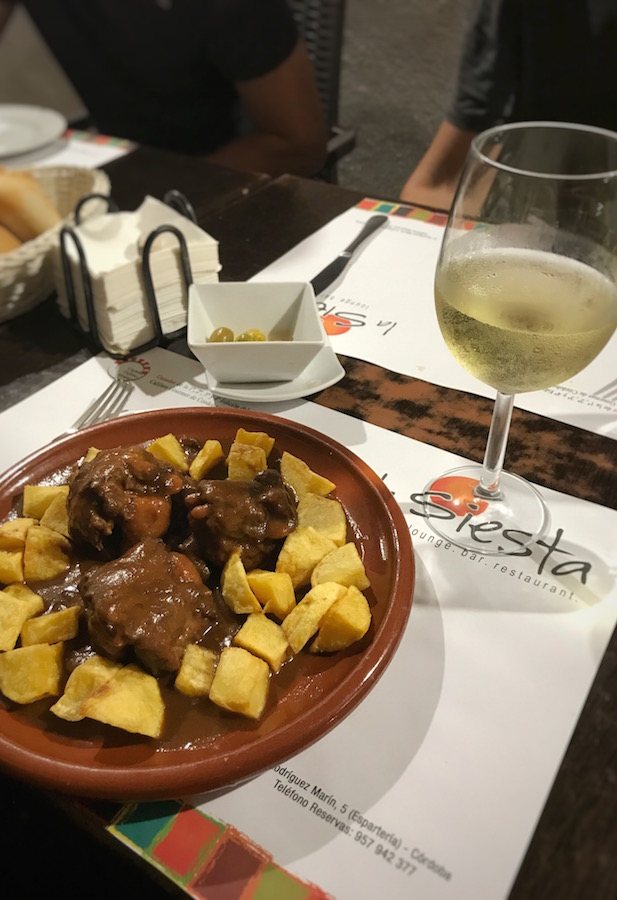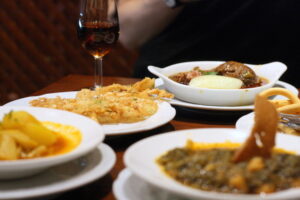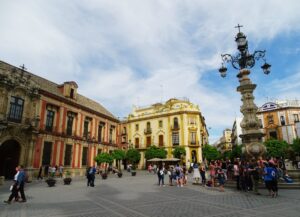Last Updated on November 21, 2025 by Cassandra Gambill | Published: October 3, 2018
Casual tapas take a lot of the credit, but the real gems of Spanish cuisine lie in the home-cooked recipes that have been passed down for centuries—the foods that are practically made to be savored among family in a cozy home. For us, one of the first things we think of that fits the bill is rabo de toro, or bull’s tail stew.
This fall-off-the-bone, melt-in-your-mouth meat cooks to perfection for several hours in a rich, hearty sauce that’s perfect for soaking up with delicious homemade bread. The hearty concoction might not be on many visitors’ radar when they come to Spain, but don’t overlook it when you see it on menus. We guarantee it will be love at first bite.
Centuries of tradition
When you tuck into a soul-warming plate of rabo de toro, you’re continuing a culinary tradition that dates back to the ancient Romans. It became quite common in Córdoba in the 16th century. However, it wasn’t until the late 19th century that it became a staple of Spanish gastronomy.
Those were the glory days of bullfighting, when master toreros drew hordes of spectators to the old Los Tejares bullring in Córdoba. After the now-controversial spectacle ended, scores of the city’s lower-class residents would wait patiently outside the back doors of the arena. Eventually the torero himself would appear, handing out the seemingly less-than-desirable parts of the recently slaughtered bull—the ears, entrails, and of course the tail—to those gathered there. The meatier cuts, of course, were sold to wealthy businessmen and butchers.
However, the real magic happened among those humble citizens who ended up with the tail. Resourceful housewives quickly realized that rabo de toro is indeed hearty, filling and delicious. What’s more, just a few of the tails produced enough meat to feed dozens of people. The humble working-class meal soon became ubiquitous on family tables (and later, restaurant menus) throughout Córdoba. Today, you can enjoy this flavorful stew throughout the country, but especially in the south.
Delicious variations
Yolanda Linares, a Córdoba cook with nearly four decades’ experience in the kitchen, says that there’s no hard-and-fast way to make rabo de toro. “Everyone has their own recipe, their own way of making it,” she says. “Restaurants especially don’t want to be doing the same thing as everyone else. Some recipes use peas, some people add a small teaspoon of cinnamon. Some even add beer because they say it softens the meat more quickly.“
Yolanda’s method starts with searing the meat on both sides, then removing it and adding carrot, onion, tomato paste and ground tomato to the same pot. When the vegetables are softened, she adds the meat back into the pot along with cognac, cloves, salt and pepper, and red wine—”The wine is what gives it that rich, hearty taste,” she says.
Savory (with a hint of sweet) sauce blanketing oh-so-tender meat: rabo de toro is the Spanish food you never knew you needed. Order it at your meal out in Spain!
The one aspect of rabo de toro that usually sets people back is the price. For that reason, many restaurants use cheaper oxtail instead, in order to cut costs. However, to an experienced cook like Yolanda, the differences are obvious.
“It has to do with the cooking time and the texture,” she says. A good bull’s tail will take about two and a half to three hours to cook, and is infinitely more tender than oxtail.
“Some people use a pressure cooker to speed things up, but I like cooking it slowly over low heat. You’ll know it’s ready to eat when the meat starts to fall off the bone,” Yolanda tells us.
Sounds amazing, right? If you’re in the homeland of this now-famous dish, El Caballo Rojo (Calle Cardenal Herrero, 28, Córdoba) and La Siesta (Calle Enrique Romero de Torres, junto a Plaza del Potro, Córdoba) both make a fabulous rabo de toro. Whenever you find yourself in Spain’s capital, try it at El Anciano Rey de los Vinos (Calle de Bailén, 19, Madrid), which serves a unique twist on the classic dish (more on that in a bit!).

A changing classic
Today, there are variations of rabo de toro that would have seemed unthinkable just a few decades ago. One of the star dishes at La Tranquera (Calle Cardenal Gonzalez, 53 Córdoba), a Spanish-South American fusion restaurant in Córdoba, is their Argentinian-style empanada stuffed with rabo de toro prepared the Spanish way. We also love the one-of-a-kind regalitos de rabo de toro at El Anciano Rey de los Vinos in Madrid.
Regalitos de rabo de toroat Madrid’s El Anciano Rey de los Vinos.
“When we met the owners, it was such a pleasant surprise to see that they were adding a slightly modern touch to their family’s traditional recipes,” Lauren says. The regalito de rabo de toro “takes something as traditional as it gets and elevates it to another level by wrapping it in traditional puff pastry and topping it with a gorgeous Spanish piquillo pepper and the gravy from the stew.”
However, some places take things to another level altogether. Ramen is the new must-have item on the international food scene, and in Madrid, you can find it prepared with rabo de toro at Lamian (Plaza Mostenses, 4), a modern Asian locale.








